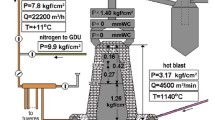Abstract
An application of expert hierarchical control is described in this paper. The control is implemented in a two-level configuration, where the lower layer performs direct regulation control and the upper layer performs supervisory functions. In the regulation layer, a rule-based controller performs the regulation task, where the controller is constructed upon causal relations between subsystems. The control action is inferred from the measurement of both controlled and noncontrolled variables. In the supervisory layer, the main function is a fault diagnosis system which diagnoses faults on-line. The diagnosis is based upon reasoning from the structure of the system and the functions of its components, and efficient diagnosis is achieved by dividing the system into several subsystems. The overall technique has been successfully implemented on a pilot scale mixing process under on-line computer control.
Similar content being viewed by others
References
Francis, J.C. and Leitch, R.R., Artifact: a real-time shell for intelligent feedback control, in Research and Development in Expert Systems (ed. M.A. Bramer), Cambridge University Press (1985).
Mamdani, Abe and Efstathiou, Janet (eds), Expert Systems and Optimisation in Process Control, Technical Press (1986).
Davis, R., Diagnosis via causal reasoning: paths of interaction and the locality principle, in AAAI-83, Washington D.C. (Aug. 1983), pp. 88–94.
Milne, R., Strategies for diagnosis, in IEEE Trans. on Systems, Man, and Cybernetics, SMC-17, 3 (1987), 333–339.
Scarl, E.A., Jamieson, J.R., and Delaune, C.I., Diagnosis and sensor validation through knowledge of structure and function, in IEEE Trans. Systems, Man, and Cybernetics, SMC-17, 3 (1987) 360–368.
Haspel, D. and Taunton, C., Application of rule based control in the cement industry, in Expert Systems and Optimisation in Process Control (eds Abe Mamdani and Janet Efstathiou), Technical Press (1986).
Paterson, A., Sachs, P., and Turner, M., ESCORT: the application of causal knowledge to real-time process control, in Expert Systems 85 (ed. Martin Marry) Cambridge University Press (1985).
Yamada, N. and Motoda, H., A diagnosis method of dynamic system using the knowledge on system description, in IJCAI-83, Karlsruhe, West Germany (1983) 225–229.
Ellis, J.E., Wadwani, D.S., Maxwell, C., and Das, S.N., Supervisory direct digital control of a mixing process, The City University Research Memorandum, CEC/JEE-DSW-CM-SND/42 (1986).
Chen, S., Wadwani, D.S., and Roberts, P.D., Asynchronous serial data communication between a BBC microcomputer and a DEC LSI 11/23 minicomputer, The City University Research Memorandum, CEC/SC-DSW-PDR/26 (1985).
Johnson, L., Expert Systems Technology: A Guide, Abacus Press (1984).
Jackson, P., Introduction to Expert Systems, Addison-Wesley (1986).
Author information
Authors and Affiliations
Rights and permissions
About this article
Cite this article
Zhang, J., Roberts, P.D. & Ellis, J.E. An application of expert systems techniques to the on-line control and fault diagnosis of a mixing process. J Intell Robot Syst 1, 209–223 (1988). https://doi.org/10.1007/BF00238766
Received:
Issue Date:
DOI: https://doi.org/10.1007/BF00238766




